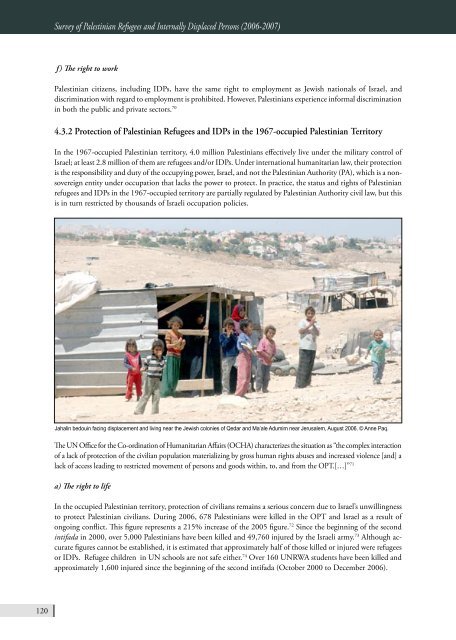BADIL Resource Center for Palestinian Residency and Refugee
BADIL Resource Center for Palestinian Residency and Refugee
BADIL Resource Center for Palestinian Residency and Refugee
Create successful ePaper yourself
Turn your PDF publications into a flip-book with our unique Google optimized e-Paper software.
120<br />
Survey of <strong>Palestinian</strong> <strong>Refugee</strong>s <strong>and</strong> Internally Displaced Persons (2006-2007)<br />
f) The right to work<br />
<strong>Palestinian</strong> citizens, including IDPs, have the same right to employment as Jewish nationals of Israel, <strong>and</strong><br />
discrimination with regard to employment is prohibited. However, <strong>Palestinian</strong>s experience in<strong>for</strong>mal discrimination<br />
in both the public <strong>and</strong> private sectors. 70<br />
4.3.2 Protection of <strong>Palestinian</strong> <strong>Refugee</strong>s <strong>and</strong> IDPs in the 1967-occupied <strong>Palestinian</strong> Territory<br />
In the 1967-occupied <strong>Palestinian</strong> territory, 4.0 million <strong>Palestinian</strong>s effectively live under the military control of<br />
Israel; at least 2.8 million of them are refugees <strong>and</strong>/or IDPs. Under international humanitarian law, their protection<br />
is the responsibility <strong>and</strong> duty of the occupying power, Israel, <strong>and</strong> not the <strong>Palestinian</strong> Authority (PA), which is a nonsovereign<br />
entity under occupation that lacks the power to protect. In practice, the status <strong>and</strong> rights of <strong>Palestinian</strong><br />
refugees <strong>and</strong> IDPs in the 1967-occupied territory are partially regulated by <strong>Palestinian</strong> Authority civil law, but this<br />
is in turn restricted by thous<strong>and</strong>s of Israeli occupation policies.<br />
Jahalin bedouin facing displacement <strong>and</strong> living near the Jewish colonies of Qedar <strong>and</strong> Ma’ale Adumim near Jerusalem, August 2006. © Anne Paq.<br />
The UN Office <strong>for</strong> the Co-ordination of Humanitarian Affairs (OCHA) characterizes the situation as “the complex interaction<br />
of a lack of protection of the civilian population materializing by gross human rights abuses <strong>and</strong> increased violence [<strong>and</strong>] a<br />
lack of access leading to restricted movement of persons <strong>and</strong> goods within, to, <strong>and</strong> from the OPT.[…]” 71<br />
a) The right to life<br />
In the occupied <strong>Palestinian</strong> territory, protection of civilians remains a serious concern due to Israel’s unwillingness<br />
to protect <strong>Palestinian</strong> civilians. During 2006, 678 <strong>Palestinian</strong>s were killed in the OPT <strong>and</strong> Israel as a result of<br />
ongoing conflict. This figure represents a 215% increase of the 2005 figure. 72 Since the beginning of the second<br />
intifada in 2000, over 5,000 <strong>Palestinian</strong>s have been killed <strong>and</strong> 49,760 injured by the Israeli army. 73 Although accurate<br />
figures cannot be established, it is estimated that approximately half of those killed or injured were refugees<br />
or IDPs. <strong>Refugee</strong> children in UN schools are not safe either. 74 Over 160 UNRWA students have been killed <strong>and</strong><br />
approximately 1,600 injured since the beginning of the second intifada (October 2000 to December 2006).

















